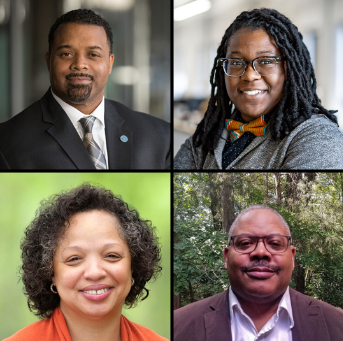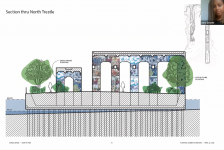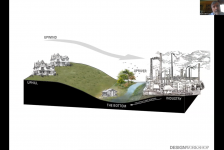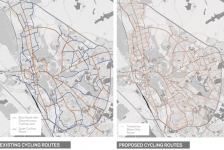Sparked by the murders of Black Americans by police officers, rebellions in many cities have revealed systemic disparities in the living conditions of people based on race, class and gender. The built environment is going through a rapid re-examination of its role in enabling or inhibiting social equity and racial justice. How could this impact how landscape architects are taught and how they practice? How could we encode equity and justice into our work? In this interactive session, multidisciplinary panelists will offer insight into what equity and justice mean, especially when working in economically, socio-culturally, and ecologically unjust places. Participants will be invited to participate in visioning new strategies for equipping landscape

Panelists
Fred Brown
Fred Brown is President and CEO of The Forbes Funds, a philanthropic organization focused on strengthening the management capacity and impact of community nonprofits in the Pittsburgh area. TFF is an Intermediary Foundation that serves 12 counties in SWPA, providing capacity-building support to nonprofit organizations in the human services and community development arenas. For 35 years, TFF has been an innovative leader addressing the needs of over 2,200 nonprofit organizations in the Pittsburgh region, specializing in fiscal management, strategic planning, back office support, mergers, acquisitions, and organizational sun setting.
Breeze Outlaw
Breeze Outlaw is a landscape designer at Sasaki in Watertown, Mass. whose work addresses the perceptual and physical connections of equitable and just access to public spaces. In zir work, zie explores frameworks of equity that emphasize place-keeping through black futurism, cultural expression, and natural systems. Breeze’s belief in design as a tool to empower people and reflect place has allowed zir to collaborate with community stakeholders, food producers, artists, organizers, and municipalities on projects that address challenges ranging from food access disparities, gentrification, and affirming spaces for black womxn. Breeze holds a Bachelor of Architecture and Master of Landscape Architecture from North Carolina State University, is a recipient of an ASLA Certificate of Honor, ASLA Student Honor Award, and is a Landscape Architecture Foundation Olmsted Scholar. Zie is also the co-founder of Blackscapes, an initiative aimed at exploring the intersection of the black experience in the built environment.
Vernice Miller-Travis
Vernice Miller-Travis is Executive Vice President of The Metropolitan Group. In addition to being a co-founder of WeACT and a pioneer in the Environmental Justice Movement, she is an expert in multicultural engagement and organizational development with significant expertise in clean air and water, regulatory systems and environmental and urban planning. Vernice consults for federal and state agencies, foundations and nonprofits. Prior to becoming a consultant, she established the environmental justice program for NRDC and initiated the environmental justice grantmaking portfolio for the Ford Foundation. Vernice has extensive experience working with communities that have undergone economic disinvestment and environmental degradation by facilitating community-based planning and implementing community revitalization and sustainable redevelopment initiatives and projects. She has the proven ability to bring unlikely partners and diverse stakeholders from all sectors together and to help find shared goals and solutions. She is trained in environmental conflict mediation, alternative dispute resolution, and how to navigate longstanding racial, cultural and economic conflicts.
Moderator
Kofi Boone, ASLA
Kofi Boone, ASLA is a Professor of Landscape Architecture at NC State University in the College of Design. Kofi is a Detroit native and a graduate of the University of Michigan (BSNR 1992, MLA 1995). His work is in the overlap between landscape architecture and environmental justice with specializations in democratic design, digital media, and interpreting cultural landscapes. His teaching and professional work have earned numerous awards including student and professional ASLA awards. He serves on the Board of Directors of the Conservation Network as well as the Landscape Architecture Foundation where he is Vice President of Education. He is a frequent speaker at national conferences and events. His published work is broadly disseminated in peer-reviewed and popular media and he is a frequent contributor to Landscape Architecture Magazine.
Learning Objectives
-
Participants will increase their understanding of the differences between the terms equity and justice as well as their implications from multidisciplinary lenses.
-
Participants will gain an awareness of case studies reflecting how social equity and racial justice were embedded within built environmental work processes and measured to determine their effectiveness.
-
Participants will collaborate in the process of translating findings into strategies to impact the teaching and practice of landscape architecture.
-
Participants will gain information to support the protection of the health, safety, and welfare of communities facing inequity and injustice,
-
Accreditation: Although the review period is officially ended, the window closed in the nascent stages of the current rebellion. The current state of affairs has challenged all sectors, including the academic sector. How could we learn from the spirit of the times and infuse social equity and racial justice into our programs and classrooms?
-
SITES: SITES was revolutionary in providing metrics and rewards for the ecological process and material impacts of sustainable site design. However, it has fallen short on human factors. How might the social equity and racial justice impacts of site design be measured and rewarded in SITES?
-
ASLA Strategic Plan: ASLA is currently going through an ASLA CEO search. The new CEO will have a mandate to develop a strategic plan to guide the organization through turbulent times. How might social equity and racial justice be infused into this strategic plan?
Following the session, the information will be compiled and we will work with the webinar participants and others to position and advocate for the recommendations in a range of organizations.
Sponsorship funds were donated to The Urban Studio.
—
Lead Image: Kofi Boone, 2017



![Equity, Justice, and Landscape [Webinar]](https://land8.com/wp-content/uploads/2020/06/HKOJ2017_kb-800x450.jpg)









J. Robert (Bob) Wainner
With all due respect….I will decline to participate. WHY does it seem that NOW…..the Landscape Architecture Profession is being pulled into this….discussion of “so called” injustice and inequity in America? Where was everyone for (8) years when Barrack Obama (the first African American/Black) was President of The United Stats? IMO, President Trump has already done more for the Black & Latino Communities in his 3-1/2 years in the White House than what Mr. Obama did in 8 full years in the White House……I’m just wondering WHY is that?
Suddenly, we have all of these “Activists” who IMO, are Anti-American….have no respect for the History of our great Nation. They want to destroy & remove every Statute. You can’t ERASE History…..History will always be a part of WHO we are. Though, we can definitely “learn” from it as we move forward.
I think EVERY High School Graduate in the United States should be “required” to serve a minimum of (2) years for the U.S. Government, in some capacity….not necessarily in the Military. But, serve America and lean what HOW to be a true Patriot of this Nation. I served (voluntarily) in the U.S Navy. I was a YN2, Administrative Assistant to the Air Wing Commanding Officer on an Aircraft Carrier in the Mediterranean Sea…from 1970 to 1974. I served America proudly and would do it again. I learned to respect our Country and our Flag. And, by serving (4) years in the U.S. Navy and “Honorably Discharged”, I earned the right to use the G.I. Bill to assist me with my expenses to earn my B.S.L.A. Degree in Landscape Architecture @ Texas A&M University in 1977….I graduated from Texas A&M University with ZERO debt.
And, I have recently read statements released by the ASLA…..and it’s VERY OBVIOUS to me, that ASLA has a VERY Liberal agenda! IMO, ASLA should be representing EVERY Landscape Architect in America…..not just the Liberal Landscape Architects.
IMO…..Landscape Architecture has no place in the “Political Arena”.
Very Respectfully,
J. Robert (Bob) Wainner
Pingback: Black History Month Feature: Cultural Landscape Reflection & The Urban Studio | Coastal Maine Botanical Gardens